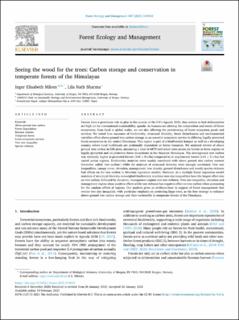| dc.description.abstract | Forests have a prominent role to play in the success of the UN’s Agenda 2030, thus actions to halt deforestation are high on the international sustainability agenda. As humans are altering the composition and extent of forest ecosystems, from local to global scales, we are also affecting the provisioning of forest ecosystem goods and services. We tested how measures of biodiversity, structural diversity, forest disturbances and environmental variables affect above ground tree carbon storage as an essential ecosystem service in differing legally protected forest ecosystems in the central Himalayas. This region is part of a biodiversity hotspot as well as a developing country where rural livelihoods are profoundly dependent on forest resources. We analysed drivers of above ground tree carbon in 530 plots, measuring a total of 6879 individual trees across six forests in three regions in legally protected and un-protected forest ecosystems in the Nepalese Himalayas. The aboveground tree carbon was markedly higher in protected forests (164 ± 8 t/ha) compared to in unprotected forests (114 ± 5 t/ha) but varied across regions. Biodiversity matrices were weakly correlated with above ground tree carbon content (hereafter called ‘tree carbon’) while the matrices of structural diversity were strongly correlated. Tree size inequalities, canopy cover, elevation, management, tree density, ground disturbance and woody species richness had effects on the tree carbon in bivariate regression models. However, in a multiple linear regression model matrices of structural diversity outweighed biodiversity matrices; tree size inequalities have the largest effect size on tree carbon, followed by elevation, management regime and tree richness. Tree size inequality, elevation and management regime show positive effects while tree richness has negative effect on tree carbon when accounting for the random effects of regions. Our analysis gives an evidence-base in support of forest management that retains tree size inequality, with particular emphasis on protecting large trees, as the best strategy to enhance above ground tree carbon storage and their co-benefits in temperate forests of the Himalayas. | en_US |

